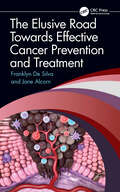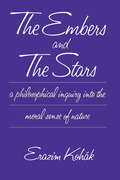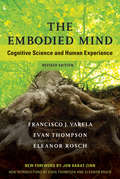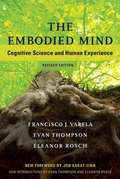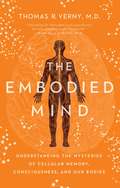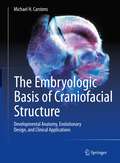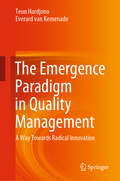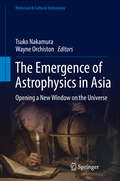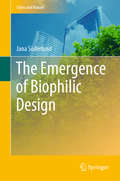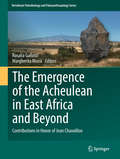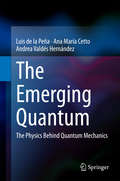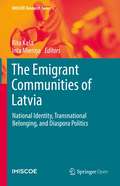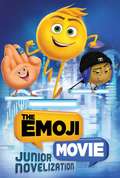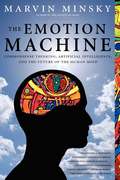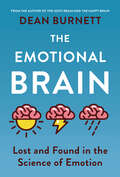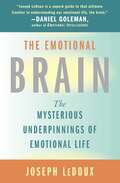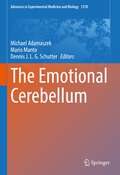- Table View
- List View
The Elusive Road Towards Effective Cancer Prevention and Treatment
by Franklyn De Silva Jane AlcornCancer will remain a global major health problem unless new diagnostic, prognostic, and management approaches are discovered to address both loss of life and quality of life. Here we summarize the general physiology, pathology, heterogeneity, and evolution of cancer, current status, limitations and challenges associated with prevention, incidence, treatment, survival, and mortality, as well as future directions with regards to solid tumors. Perspectives are provided on how to improve pre-clinical understandings, outcomes, and patient care. Further, this comprehensive, timely overview of the literature has educational value as part of an academic course, seminar, or as a supplementary text.
The Embers and the Stars: A Philosophical Inquiry into the Moral Sense of Nature
by Erazim Kohák"It is hard to put this profound book into a category. Despite the author's criticisms of Thoreau, it is more like Walden than any other book I have read. . . . The book makes great strides toward bringing the best insights from medieval philosophy and from contemporary environmental ethics together. Anyone interested in both of these areas must read this book."—Daniel A. Dombrowski, The Thomist "Those who share Kohák's concern to understand nature as other than a mere resource or matter in motion will find his temporally oriented interpretation of nature instructive. It is here in particular that Kohák turns moments of experience to account philosophically, turning what we habitually overlook or avoid into an opportunity and basis for self-knowledge. This is an impassioned attempt to see the vital order of nature and the moral order of our humanity as one."—Ethics
The Embodied Mind, revised edition: Cognitive Science and Human Experience (The\mit Press Ser.)
by Evan Thompson Francisco J. Varela Eleanor RoschA new edition of a classic work that originated the “embodied cognition” movement and was one of the first to link science and Buddhist practices.This classic book, first published in 1991, was one of the first to propose the “embodied cognition” approach in cognitive science. It pioneered the connections between phenomenology and science and between Buddhist practices and science—claims that have since become highly influential. Through this cross-fertilization of disparate fields of study, The Embodied Mind introduced a new form of cognitive science called “enaction,” in which both the environment and first person experience are aspects of embodiment. However, enactive embodiment is not the grasping of an independent, outside world by a brain, a mind, or a self; rather it is the bringing forth of an interdependent world in and through embodied action. Although enacted cognition lacks an absolute foundation, the book shows how that does not lead to either experiential or philosophical nihilism. Above all, the book's arguments were powered by the conviction that the sciences of mind must encompass lived human experience and the possibilities for transformation inherent in human experience. This revised edition includes substantive introductions by Evan Thompson and Eleanor Rosch that clarify central arguments of the work and discuss and evaluate subsequent research that has expanded on the themes of the book, including the renewed theoretical and practical interest in Buddhism and mindfulness. A preface by Jon Kabat-Zinn, the originator of the mindfulness-based stress reduction program, contextualizes the book and describes its influence on his life and work.
The Embodied Mind: Cognitive Science and Human Experience
by Evan Thompson Francisco J. Varela Eleanor RoschThe Embodied Mind provides a unique, sophisticated treatment of the spontaneous and reflective dimension of human experience. The authors argue that only by having a sense of common ground between mind in Science and mind in experience can our understanding of cognition be more complete. Toward that end, they develop a dialogue between cognitive science and Buddhist meditative psychology and situate it in relation to other traditions such as phenomenology and psychoanalysis.
The Embodied Mind: Cognitive Science and Human Experience
by Jon Kabat-Zinn Evan Thompson Francisco J. Varela Eleanor RoschThis classic book, first published in 1991, was one of the first to propose the "embodied cognition" approach in cognitive science. It pioneered the connections between phenomenology and science and between Buddhist practices and science -- claims that have since become highly influential. Through this cross-fertilization of disparate fields of study, The Embodied Mind introduced a new form of cognitive science called "enaction," in which both the environment and first person experience are aspects of embodiment. However, enactive embodiment is not the grasping of an independent, outside world by a brain, a mind, or a self; rather it is the bringing forth of an interdependent world in and through embodied action. Although enacted cognition lacks an absolute foundation, the book shows how that does not lead to either experiential or philosophical nihilism. Above all, the book's arguments were powered by the conviction that the sciences of mind must encompass lived human experience and the possibilities for transformation inherent in human experience. This revised edition includes substantive introductions by Evan Thompson and Eleanor Rosch that clarify central arguments of the work and discuss and evaluate subsequent research that has expanded on the themes of the book, including the renewed theoretical and practical interest in Buddhism and mindfulness. A preface by Jon Kabat-Zinn, the originator of the mindfulness-based stress reduction program, contextualizes the book and describes its influence on his life and work.
The Embodied Mind: Understanding the Mysteries of Cellular Memory, Consciousness, and Our Bodies
by Thomas R. VernyAs groundbreaking synthesis that promises to shift our understanding of the mind-brain connection and its relationship with our bodies.We understand the workings of the human body as a series of interdependent physiological relationships: muscle interacts with bone as the heart responds to hormones secreted by the brain, all the way down to the inner workings of every cell. To make an organism function, no one component can work alone. In light of this, why is it that the accepted understanding that the physical phenomenon of the mind is attributed only to the brain? In The Embodied Mind, internationally renowned psychiatrist Dr. Thomas R. Verny sets out to redefine our concept of the mind and consciousness. He brilliantly compiles new research that points to the mind&’s ties to every part of the body. The Embodied Mind collects disparate findings in physiology, genetics, and quantum physics in order to illustrate the mounting evidence that somatic cells, not just neural cells, store memory, inform genetic coding, and adapt to environmental changes—all behaviors that contribute to the mind and consciousness. Cellular memory, Verny shows, is not just an abstraction, but a well-documented scientific fact that will shift our understanding of memory. Verny describes single-celled organisms with no brains demonstrating memory, and points to the remarkable case of a French man who, despite having a brain just a fraction of the typical size, leads a normal life with a family and a job. The Embodied Mind shows how intelligence and consciousness—traits traditionally attributed to the brain alone—also permate our entire being. Bodily cells and tissues use the same molecular mechanisms for memory as our brain, making our mind more fluid and adaptable than we could have ever imaged.
The Embryologic Basis of Craniofacial Structure: Developmental Anatomy, Evolutionary Design, and Clinical Applications
by Michael H. CarstensFocusing on the anatomy of the head and neck, this book begins at the cellular level of development, detailing bone, muscle, blood supply, and innervation along the way. It illustrates the origin of each tissue structure to aid in making prognoses beyond the surface deformation, offering typical issues seen in the craniofacial region, for example. Written by a pediatric Craniofacial plastic surgeon and intended for clinicians and residents in the areas of plastic surgery, ENT, maxillofacial surgery, and orthodontistry, this book is the first of its kind to focus so intently on evolution of the craniofacial structure. It is neatly broken up into two distinct sections.The first section is meant for readers to gain a fundamental understanding of the development of craniofacial structures, from embryo onward, relying on the concepts of the Neuromeric Theory. The chapters in the first section of the book trace the development of the typical patient. The second section offers clinical examples of how the Neuromeric Theory can be used to repair or reconstruct various regions of the head and neck. Craniofacial clefts, including cleft lip and palate, ocular hypotelorism, anencephaly, craniosynostosis and more are detailed. Understanding the formation of the tissue structures involved in any given genetic deformation or anomaly enables the clinician to provide a more satisfying outcome for the patient, both structurally and aesthetically. New and current therapeutic options are explored and supported through original illustrations and photographs to aid in determining the best treatment for each individual patient.Embryological Principles of Craniofacial Structure bridges the gap between introductory books on the basic anatomy of the head and neck and the detailed understanding required for corrective surgery of craniofacial defects.
The Emerald Horizon: The History of Nature in Iowa
by Cornelia F. MutelBeginning with the geological forces that shaped the land, Mutel traces the evolution of Iowa's prairies and woodlands to the present time. She emphasizes the dramatic impact of Euro-American settlement and shows how farming and logging have destroyed fragile prairie and forest abitats. She discusses the potential of restoration and provides information for those who wish to launch restoration programs. The issues prominent in Iowa mirror those to be encountered in other prairie states.
The Emergence Paradigm in Quality Management: A Way Towards Radical Innovation
by Teun Hardjono Everard van KemenadeThis book is focused on quality management, and four different lenses which can be used to explore the phenomenon. It introduces emergence as a paradigm in thinking about quality, and explores conditions which are beneficial to radical innovation. The Emergence Paradigm in Quality Management provides an overview of the existing movements in thinking about quality, and discusses why these movements in fact represent paradigms. Three paradigms, the Empirical Paradigm, the Reference Paradigm and the Reflective Paradigm, are explained followed by a search for the Fourth Paradigm, the so-called Emergence Paradigm, which presents a route to radical innovation in organizations when plans, strategies and models fail. It presents the debates around the paradigms, and explores which is the best approach. This professional text will be ideal for strategy and policy makers wanting to establish a link between their conceived plans and the attention for quality, while finding ways to facilitate innovation. Professionals in a range of for-profit and non-profit organizations, including healthcare, will be able to expand their knowledge on quality management, operations management, and organizational studies.
The Emergence of Astrophysics in Asia
by Wayne Orchiston Tsuko NakamuraThis book examines the ways in which attitudes toward astronomy in Australia, China, India, Indonesia, Japan, South Korea, New Zealand, Taiwan, Thailand and Uzbekistan have changed with the times. The emergence of astrophysics was a worldwide phenomenon during the late nineteenth and early twentieth centuries, and it gradually replaced the older-style positional astronomy, which focused on locating and measuring the movements of the planets, stars, etc. . Here you will find national overviews that are at times followed by case studies of individual notable achievements. Although the emphasis is on the developments that occurred around 1900, later pioneering efforts in Australian, Chinese, Indian and Japanese radio astronomy are also included. As the first book ever published on the early development of astrophysics in Asia, the authors fill a chronological and technological void. Though others have already written about earlier astronomical developments in Asia, and about the recent history of astronomy in various Asian nations, no one has examined the emergence of astrophysics, the so-called 'new astronomy' in Asia during the late nineteenth and early twentieth centuries.
The Emergence of Biophilic Design (Cities and Nature)
by Jana SöderlundThis book addresses the emergence of biophilic design, a form of design that looks at people’s intrinsic connection with nature. There is no denying that biophilic design is rapidly expanding globally as an effective response to pressing issues in urban areas and built environments. From being a term few had heard of in 2012, when the author’s research began, to one that is currently trending in a broad range of disciplines, the story of its emergence has never been properly told. The story of the emergence of biophilic design is the story of a social movement and how a gathering of people with a common interest and passion can spark a global trend. The book and the stories within are not only engaging but also informative and educational, offering readers an in-depth understanding of what biophilic design is all about, and how to promote its implementation in their own built environment. Hopefully, they will inspire people to act, to campaign and to implement initiatives in their urban environment, with the confidence that they are capable of making a difference. The author spent three years researching the emergence of biophilic design, and why and how it was driven by certain people who championed the concept. Part of the author’s research involved a three-month tour of ten North American cities, during which she interviewed 26 key players. These people ranged from community leaders, landscape architects, and academics, to the CEOs of NGOs and government leaders. The result is a collection of stories that illustrate the evolution of biophilic design, and how it was frequently born from a passion for, belief in and love of nature, as well as a response to an urban crisis.
The Emergence of Eternal Life
by William J. HoyeThe question of whether life exists beyond death remains one of the most pertinent of our existence, and theologians continue to address what relevance the answer has for our life in the present. In this book, William J. Hoye uses the phenomenon of emergence - the way higher forms of existence arise from a collection of simpler interactions - as a framework for understanding and defending the concept of eternal life, showing how it 'emerges' from our present life, our human longing for fulfilment and happiness, and our striving for knowledge of reality. Hoye uses the work of Karl Rahner and Thomas Aquinas to explore questions concerning suffering, the ultimate relevance of morality, and how the fundamental idea of responsibility changes when viewed eschatologically. Contemporary reasons for denying an afterlife are examined critically and extensively. This book will be of great interest to those studying systematic theology, theological anthropology and Catholic theology.
The Emergence of Indigenous Peoples
by Rodolfo StavenhagenThis is the second part of a trilogy published in the Springer Briefs on Pioneers in Science and Practice on the occasion of the 80th birthday of Rodolfo Stavenhagen, a distinguished Mexican sociologist and professor emeritus of El Colegio de Mexico. Rodolfo Stavenhagen wrote this collection of six essays on The Emergence of Indigenous Peoples between 1965 and 2009. These widely discussed classic texts address: Classes, Colonialism and Acculturation (1965); Indigenous Peoples: An Introduction (2009); The Return of the Native: The Indigenous Challenge in Latin America (2002); Indigenous Peoples in Comparative Perspective (2004); Mexico's Unfinished Symphony: The Zapatista Movement (2000); and Struggle and Resistance: Mexico's Indians in Transition (2006). This volume discusses the emergence of indigenous peoples as new social and political actors at the national and international level. These texts deal with human rights, especially during the years he the author served as United Nations special rapporteur on the rights of indigenous peoples.
The Emergence of Life
by Luisi Pier LuigiThe origin of life from inanimate matter has been the focus of much research for decades, both experimentally and philosophically. Luisi takes the reader through the consecutive stages from prebiotic chemistry to synthetic biology, uniquely combining both approaches. This book presents a systematic course discussing the successive stages of self-organisation, emergence, self-replication, autopoiesis, synthetic compartments and construction of cellular models, in order to demonstrate the spontaneous increase in complexity from inanimate matter to the first cellular life forms. A chapter is dedicated to each of these steps, using a number of synthetic and biological examples. With end-of-chapter review questions to aid reader comprehension, this book will appeal to graduate students and academics researching the origin of life and related areas such as evolutionary biology, biochemistry, molecular biology, biophysics and natural sciences.
The Emergence of Religion in Human Evolution (Routledge Studies in Neurotheology, Cognitive Science and Religion)
by Christopher J. Corbally Margaret Boone RappaportReligious capacity is a highly elaborate, neurocognitive human trait that has a solid evolutionary foundation. This book uses a multidisciplinary approach to describe millions of years of biological innovations that eventually give rise to the modern trait and its varied expression in humanity’s many religions. The authors present a scientific model and a central thesis that the brain organs, networks, and capacities that allowed humans to survive physically also gave our species the ability to create theologies, find sustenance in religious practice, and use religion to support the social group. Yet, the trait of religious capacity remains non-obligatory, like reading and mathematics. The individual can choose not to use it. The approach relies on research findings in nine disciplines, including the work of countless neuroscientists, paleoneurologists, archaeologists, cognitive scientists, and psychologists. This is a cutting-edge examination of the evolutionary origins of humanity’s interaction with the supernatural. It will be of keen interest to academics working in Religious Studies, Neuroscience, Cognitive Science, Anthropology, Evolutionary Biology, and Psychology.
The Emergence of Spacetime in String Theory (Routledge Studies in the Philosophy of Mathematics and Physics)
by Tiziana VistariniThe nature of space and time is one of the most fascinating and fundamental philosophical issues which presently engages at the deepest level with physics. During the last thirty years this notion has been object of an intense critical review in the light of new scientific theories which try to combine the principles of both general relativity and quantum theory—called theories of quantum gravity. This book considers the way string theory shapes its own account of spacetime disappearance from the fundamental level.
The Emergence of the Acheulean in East Africa and Beyond (Vertebrate Paleobiology And Paleoanthropology Ser.)
by Rosalia Gallotti Margherita MussiThis edited volume presents current archaeological research and data from the major early Acheulean sites in East Africa, and addresses three main areas of focus; 1) the tempo and mode of technological changes that led to the emergence of the Acheulean in East Africa; 2) new approaches to lithic collections, including lithic technology analyses; and 3) the debated coexistence of the Developed Oldowan and the early Acheulean. The chapters are the proceedings from the workshop titled “The Emergence of the Acheulean in East Africa”, held at University of Rome “La Sapienza” on September 12–13, 2013. The aim of the workshop was to bring together researchers currently working in this field in East Africa, in order to define the characteristics and the evolution of the early Acheulean. The volume was expanded with some chapters on the preceding Oldowan, on the African fauna and on paleovegetation, on the Acheulean in Asia and, eventually, on the Acheulean in Europe. The book is addressed to the scientific community, and will be of interest to researchers, graduate students, archaeologists, paleontologists, and paleoanthropologists. This volume is dedicated to the memory of Jean Chavaillon (March 25, 1925 - December 21, 2013), the leading archaeologist and Quaternary geologist who researched with unfailing enthusiasm the earliest human cultures and directed from 1965 to 1995 the French Archaeological Mission at Melka Kunture.
The Emerging Quantum
by Luis de la Peña Ana María Cetto Andrea Valdés HernándezThis monograph presents the latest findings from a long-term research project intended to identify the physics behind Quantum Mechanics. A fundamental theory for quantum mechanics is constructed from first physical principles, revealing quantization as an emergent phenomenon arising from a deeper stochastic process. As such, it offers the vibrant community working on the foundations of quantum mechanics an alternative contribution open to discussion. The book starts with a critical summary of the main conceptual problems that still beset quantum mechanics. The basic consideration is then introduced that any material system is an open system in permanent contact with the random zero-point radiation field, with which it may reach a state of equilibrium. Working from this basis, a comprehensive and self-consistent theoretical framework is then developed. The pillars of the quantum-mechanical formalism are derived, as well as the radiative corrections of nonrelativistic QED, while revealing the underlying physical mechanisms. The genesis of some of the central features of quantum theory is elucidated, such as atomic stability, the spin of the electron, quantum fluctuations, quantum nonlocality and entanglement. The theory developed here reaffirms fundamental scientific principles such as realism, causality, locality and objectivity.
The Emigrant Communities of Latvia: National Identity, Transnational Belonging, and Diaspora Politics (IMISCOE Research Series)
by Rita Kaša Inta MieriņaThis open access volume examines experiences of contemporary Latvian migrants, thereby focusing on reasons for emigration, processes of integration in their host countries, and – in the case of return migration - re-integration in their home country. In the context of European migration, the book describes the case of Latvia, which is interesting due to the multiple waves of excessive emigration, continuously high migration potential among European Union member states, and diverse migrant characteristics. It provides a fascinating insight into the social and psychological aspects linked to migration in a comparative context. The data in this volume is rich in providing individual level perspectives of contemporary Latvian migrants by addressing issues such as emigrants’ economic, social and cultural inclusion in the host country, ties with the home country and culture, interaction with public authorities both in the host and home country, political views, and perspectives on the permanent settlement in migration or return. Through topics such as assimilation of children, relationships between emigrants representing different emigration waves, the complex identities and attachments of minority emigrants, and the role of culture and media in identity formation and presentation, this book addresses topics that any contemporary emigrant community is faced with.
The Emoji Movie Junior Novelization
by Tracey West Style GuideDiscover the world hidden inside your smartphone in this retelling of The Emoji Movie, featuring an eight-page color insert with images from the film! The Emoji Movie pops into theaters on July 28, 2017!The Emoji Movie unlocks the never-before-seen secret world inside your smartphone. Hidden within the messaging app is Textopolis, a bustling city where all your favorite Emojis live, hoping to be selected by the phone’s user. In this world, each Emoji has only one facial expression—except for Gene, an exuberant Emoji who was born without a filter and is bursting with multiple expressions. Determined to become “normal” like the other Emojis, Gene enlists the help of his handy best friend Hi-5 and the notorious rebel Emoji Jailbreak. Together, they embark on an epic “app-venture” through the apps on the phone, each its own wild and fun world, to find the code that will fix Gene. But when a greater danger threatens the phone, the fate of all Emojis depends on these three unlikely friends who must save their world before it’s deleted forever. The Emoji Movie © 2017 Sony Pictures Animation Inc. All Rights Reserved. emoji® is a registered trademark of emoji company GmbH used under license
The Emotion Machine: Commonsense Thinking, Artificial Intelligence, and the Future of the Human Mind
by Marvin MinskyIn this mind-expanding book, scientific pioneer Marvin Minsky continues his groundbreaking research, offering a fascinating new model for how our minds work. He argues persuasively that emotions, intuitions, and feelings are not distinct things, but different ways of thinking. By examining these different forms of mind activity, Minsky says, we can explain why our thought sometimes takes the form of carefully reasoned analysis and at other times turns to emotion. He shows how our minds progress from simple, instinctive kinds of thought to more complex forms, such as consciousness or self-awareness. And he argues that because we tend to see our thinking as fragmented, we fail to appreciate what powerful thinkers we really are. Indeed, says Minsky, if thinking can be understood as the step-by-step process that it is, then we can build machines -- artificial intelligences -- that not only can assist with our thinking by thinking as we do but have the potential to be as conscious as we are. Eloquently written,The Emotion Machineis an intriguing look into a future where more powerful artificial intelligences await.
The Emotional Brain: Lost and Found in the Science of Emotion
by Dean BurnettHappy, sad, angry, glad—why do we cry when we’re ecstatic or mad? A fascinating look at the science of emotionEmotions can be a pain. After his father died of Covid, Dean Burnett found himself wondering what it would be like to live without emotion. And so, he decided to put his feelings under the microscope—for science.With his trademark humour, Burnett takes us on an incredible journey of discovery, stretching from the origins of life to the ends of the universe. Along the way, he reveals why we would ever follow our gut; whether things really were better in the old days; why it’s so hard to stop doomscrolling; how sad music can make us happier; why we can’t think straight when hungry; the point of nightmares; and why it is virtually impossible to forget embarrassing memories.
The Emotional Brain: The Mysterious Underpinnings of Emotional Life
by Joseph LedouxWhat happens in our brains to make us feel fear, love, hate, anger, joy? Do we control our emotions, or do they control us? Do animals have emotions? How can traumatic experiences in early childhood influence adult behavior, even though we have no conscious memory of them? In The Emotional Brain, Joseph LeDoux investigates the origins of human emotions and explains that many exist as part of complex neural systems that evolved to enable us to survive. One of the principal researchers profiled in Daniel Goleman's Emotional Intelligence, LeDoux is a leading authority in the field of neural science. In this provocative book, he explores the brain mechanisms underlying our emotions -- mechanisms that are only now being revealed.
The Emotional Cerebellum (Advances in Experimental Medicine and Biology #1378)
by Mario Manto Michael Adamaszek Dennis J. L. G. SchutterEmotions represent a critical aspect of daily life in humans. Our understanding of the mechanisms of regulation of emotions has increased exponentially these last two decades. This book evaluates the contribution of the cerebellum to emotion. It outlines the current clinical, imaging and neurophysiological findings on the role of the cerebellum in key aspects of emotional processing and its influence on motor and cognitive function and social behavior.In the first section, the reader is introduced to the contributions of the cerebellum to various emotion domains, from emotion perception and recognition to transmission and encoding. Subsequent chapters provide a comprehensive picture of the neurophysiology and topography of emotion in the cerebellum and illustrate the convergence of theoretical and empirical research. Additional chapters address the cerebellum's involvement in emotional learning, emotional pain, emotional aspects of body language and perception, and its relations to social cognition including morality, music, and art. Finally, neuropsychiatric aspects of the cerebellum's influence on mood disorders and the current state of therapeutic options, including noninvasive stimulation approaches, complete the overview. This is the first book summarizing the current state of knowledge on the contribution of the cerebellum to important aspects of emotion. It is an essential reference for students, trainees, neuroscientists, researchers, and clinicians in neuroscience, neurology, neurosurgery and psychology involved in the study of emotions. The authors are renowned scientists in the field of cerebellar research.
The Emotional Lives of Animals (revised): A Leading Scientist Explores Animal Joy, Sorrow, and Empathy — and Why They Matter
by Marc BekoffA seminal exploration of animal emotion, sentience, and cognition, revised and expanded to incorporate a surge of new science When award-winning scientist Marc Bekoff penned the first edition of this book in 2007, he predicted that over time our understanding of animal cognition and emotion would grow “richer, more accurate, and possibly different.” Since then, not only has the field seen an explosion of new and startling research, but the popular interest in the subject has grown as well, spawning countless podcasts, articles, and bestselling books. Bekoff skillfully blends extraordinary stories of animal joy, empathy, grief, embarrassment, anger, and love with the latest scientific research confirming the existence of emotions that common sense and experience have long implied. Filled with light humor and compassion, The Emotional Lives of Animals is a clarion call for reassessing both how we view and how we treat animals.
